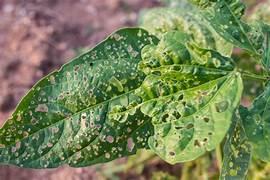Houseplant Pest & Disease Control

Taking care of your indoor plants is essential for a thriving indoor garden. Similar to all living things, houseplants are susceptible to pests and diseases. Ensuring that your plants thrive is crucial through effective control of pests and diseases in houseplants. A well-maintained garden, equipped with appropriate methods and supplies, can effectively deter pests and combat illnesses. This article will discuss various methods for controlling typical pests and diseases found in houseplants, guaranteeing the well-being and vibrancy of your indoor plants.
Understanding Common Houseplant Pests
Various pests have the potential to infest indoor plants, resulting in harm and ultimately causing the plant to die if not controlled effectively. Typical pests found in gardens are aphids, spider mites, mealybugs, and whiteflies. Early detection and control are crucial due to the rapid spread of these pests between plants. Aphids, tiny insects with soft bodies, feed on plant sap which results in curled and distorted leaves. Spider mites, however, are minuscule arachnids that produce delicate webbing and result in leaf discoloration. Mealybugs can be easily recognized by the fluffy material they deposit on the leaves and stems of plants. Finally, whiteflies are small, white-winged insects that swarm in the air when the plant is agitated. Managing these pests necessitates utilizing a mix of methods for preventing and treating them.
Preventing Pest Infestations
Houseplant pests and diseases control is the initial step in protecting your plants. In order to avoid pest infestations, it is crucial to uphold good hygiene and provide proper care for plants. Begin by examining fresh plants prior to moving them inside. Inspect new plants for any indications of pests or diseases and isolate them for a couple of weeks to verify they are in good health. Ensure your plants stay clean by gently wiping the leaves with a damp cloth to eliminate dust and possible pests. Furthermore, make sure not to water your plants excessively, as this can lead to the growth of pests such as fungus gnats. Frequently check your plants, paying close attention to the lower part of leaves and the soil, to detect any pest issues quickly. Utilizing organic pesticides or natural enemies like ladybugs or predatory mites can also assist in managing pest populations.
Identifying and Treating Common Houseplant Diseases
Houseplants can also be affected by a range of illnesses due to fungi, bacteria, and viruses besides pests. Some typical diseases found in houseplants are powdery mildew, root rot, and leaf spot. Powdery mildew is characterized by a white, powdery substance that forms on the leaves and stems of plants, but it can be controlled either by using fungicides or by improving air flow around the plants. Root rot frequently occurs as a result of excessive watering and inadequate drainage, resulting in roots that are brown and mushy. To address root rot, decrease watering and transplant the plant into new, soil that drains well. Leaf spot can be managed by getting rid of infected leaves and using an appropriate fungicide to treat the issue. Consistent observation and immediate response can stop diseases from spreading and protect your plants.
Natural and Chemical Control Methods
Different ways to manage pests and diseases in houseplants, including both natural and chemical remedies, are available. Effective against various pests without causing harm to plants or the environment, natural methods such as neem oil, insecticidal soap, and horticultural oil are used. Chemical pesticides may be required for infestations that are more severe. To reduce harm to the environment and other organisms, carefully follow the instructions and use chemical pesticides in moderation. Biocontrol methods such as the introduction of helpful insects such as lacewings and parasitic wasps can be used to naturally regulate pest populations. Using a variety of techniques can offer a holistic approach to managing pests and diseases in houseplants.
Maintaining Healthy Growing Conditions
It is crucial to create the proper growing conditions for your indoor plants in order to reduce their vulnerability to pests and diseases. Make sure your plants get enough light, water, and nutrients. Understanding your houseplants' individual needs and adjusting their care accordingly is crucial, as each plant has unique requirements. Sufficient air flow is essential to avoid the growth of fungal infections. Prevent plants from being too close together and make sure there is adequate spacing to encourage air circulation. Prune your plants often to get rid of dead or unhealthy leaves and branches that may attract pests and diseases. By ensuring ideal growing conditions, you can lower the chances of pests and diseases affecting your indoor plants.
Conclusion: The Importance of Vigilance and care
Maintaining proper control over pests and diseases is crucial for successful indoor gardening with houseplants. By familiarizing yourself with typical pests and diseases, implementing effective prevention and treatment techniques, and upholding optimal growing conditions, you can guarantee the well-being and attractiveness of your indoor plants. Monitoring consistently and taking immediate action are essential for preventing and controlling infestations and diseases. Whether you have experience in gardening or are new to indoor gardening, these tips and techniques will assist you in maintaining healthy houseplants for the long term. Don't forget, taking some time to care for and pay attention to your indoor garden can greatly help in keeping it healthy and free of pests.
- Art
- Causes
- Crafts
- Dance
- Drinks
- Film
- Fitness
- Food
- الألعاب
- Gardening
- Health
- الرئيسية
- Literature
- Music
- Networking
- أخرى
- Party
- Religion
- Shopping
- Sports
- Theater
- Wellness


